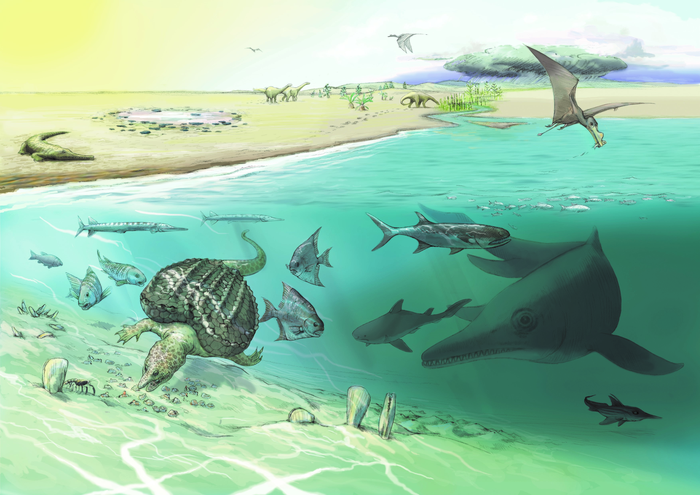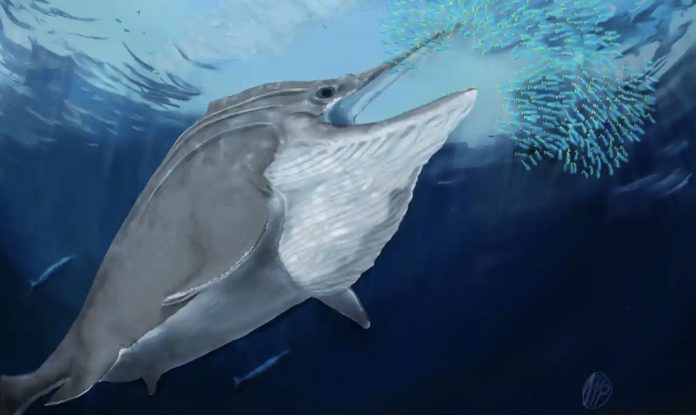Researchers have found the largest ever ichthyosaur tooth, with its width being twice as large as any aquatic reptile known
Palaeontologists have found the largest ever have ichthyosaur tooth whilst digging in the Swiss Alps between 1976 and 1990. The team have discovered sets of fossils representing three new ichthyosaurs that may have been among the largest animals to have ever lived.
The fossils were found during geological mapping in the Alps
Other incomplete skeletal remains include the largest trunk vertebra in Europe which demonstrates another ichthyosaur rivaling the largest marine reptile fossil known today, the 21-meter long Shastasaurus sikkanniensis from British Columbia, Canada.
Dr Heinz Furrer, who co-authoed this study, was among a team who recovered the fossils during geological mapping in the Kössen Formation of the Alps. More than 200 million years before, the rock layers still covered the seafloor however with the folding of the Alps, they had ended up at an altitude of 2,800 meters.
Dr Furrer said he was delighted to have uncovered “the world’s longest ichthyosaur; with the thickest tooth found to date and the largest trunk vertebra in Europe!”

Lead author P. Martin Sandler, of the University of Bonn, said: “maybe there are more remains of the giant sea creatures hidden beneath the glaciers.”
maybe there are more remains of the giant sea creatures hidden beneath the glaciers
“Bigger is always better. There are distinct selective advantages to large body size. Life will go there if it can. There were only three animal groups that had masses greater than 10–20 metric tonnes: long-necked dinosaurs (sauropods); whales; and the giant ichthyosaurs of the Triassic.”
Placing the new Ichthyosaur in time, 250 million years ago
Ichthyosaurs first emerged some 250 million years ago in the wake of the Permian extinction, when around 95% of marine species died out. Being roughly the shape of contemporary whales, ichthyosaurs had elongated bodies and erect tail fins.
The Fossils have been concentrated in North America and Europe, however ichthyosaurs have also been found in South America, Asia, and Australia. Giant species have mostly been unearthed in North America, with scanty finds from the Himalaya and New Caledonia, so the discovery of further behemoths in Switzerland represents an expansion of their known range.
Very little is known about these creatures, with evidence from the UK and New Zealand suggest that some of them were the size of blue whales. An 1878 paper credibly describes an ichthyosaur vertebrae 45 cm in diameter from there, but the fossil never made it to London and may have been lost at sea.
Sander said: “It amounts to a major embarrassment for palaeontology that we know so little about these giant ichthyosaurs despite the extraordinary size of their fossils. We hope to rise to this challenge and find new and better fossils soon.”

The second ever instance of a giant ichthyosaur with teeth
The tooth described by the paper is only the second instance of a giant ichthyosaur with teeth—the other being the 15-meter-long Himalayasaurus. These species likely occupied similar ecological roles to modern sperm whales and killer whales. Indeed, the teeth are curved inwards like those of their mammalian successors, indicating a grasping mode of feeding conducive to capturing prey such as giant squid.
“It is hard to say if the tooth is from a large ichthyosaur with giant teeth or from a giant ichthyosaur with average-sized teeth,” Sander said.
Because the tooth described in the paper was broken off at the crown, the authors were not able to confidently assign it to a particular taxon. Still, a peculiarity of dental anatomy allowed the researchers to identify it as belonging to an ichthyosaur.
“Ichthyosaurs have a feature in their teeth that is nearly unique among reptiles: the infolding of the dentin in the roots of their teeth,” commented Sander.
“The only other group to show this are monitor lizards.”











